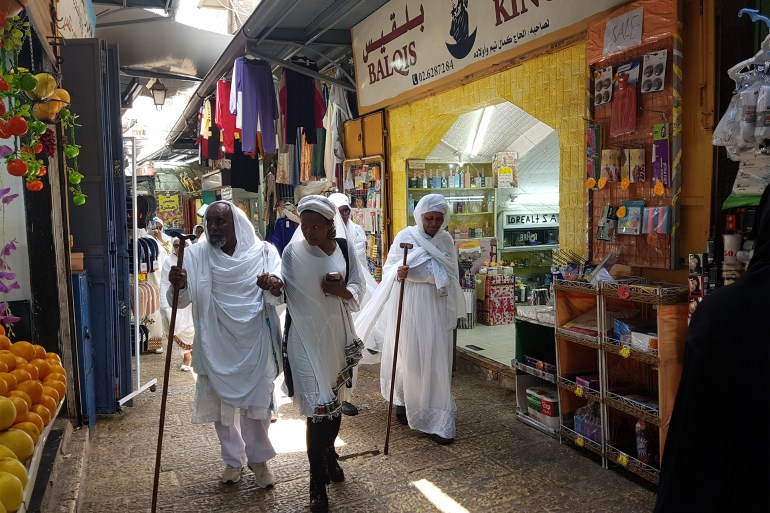Khan al-Zeit Market, home of Jerusalem's olive presses | Encyclopedia
One of the oldest and most vibrant markets in the Old City of Jerusalem, it is the face of the city, its first market, and the main entrance to the markets of the Old City in the Holy City. It holds valuable historical and cultural connotations, and is a major destination for tourists and locals who flock to buy traditional Palestinian products and unique handicrafts.
the site
Khan al-Zeit market branches off from Bab al-Amoud market, where the roads diverge from this market to the left to the al-Wad neighborhood and al-Aqsa Mosque, and to the right to Khan al-Zeit market, which extends for several hundred meters until it reaches the al-Murabba’a area, which is the intersection of the roads to the Church of the Holy Sepulchre on the right, the Attarin market to the front, Aqabat al-Saraya and the al-Qarmi neighborhood.
Khan Al-Zeit Market is divided into two sections: the first extends from the beginning of the northern market to the intersection of the market with the Christian Quarter Road and Al-Mufti Pass, and the second from Al-Mufti Pass to the entrance to Al-Attarin Market.
Reason for the name
It was named after the presence of an ancient inn in it known as “Khan Al-Zeit”, which is distinguished by its olive oil presses.
Each press had a khan dedicated to olive oil since the Mamluk period. The khan located between Aqabat al-Mufti and Aqabat al-Takiya was later transformed into homes for Jerusalemites or shops serving shoppers.
Market History
Khan Al-Zeit Market is a long street leading to the Attarin Market, which is one of the famous markets, and is considered the main Khan Al-Zeit Market in the old town.
On both sides there are shops, and it is the most diverse in terms of goods, and the variety of shops increases according to the needs of the Jerusalemite consumer.
The shops of Khan Al-Zeit market display goods, most of which are modern consumer goods, but they offer a rich variety in response to the needs of residents and visitors, from popular restaurants, sweets and nuts shops, falafel stands, and meat and vegetable shops.
Therefore, this market has lost its traditional specialization in soap and press industry under the pressure and development of life.
This street was known in the Roman and Byzantine era as the “cardo”, meaning the main joint or main road, as it was first built during the time of Emperor Hadrian (whose name was Aelius Hadrianus) in 132 AD when Jerusalem was called Aelia Capitolina.
It used to extend to the end of what is known today as the Attarin Market, but when Justinian built the Nea Church (the New Church) in the late fifth century, he extended the “cardo” until it reached the southern end of the Old City of Jerusalem, where the Prophet David’s Gate is today.
This street is divided into several sections, each section has a name and a specialty. The first section was for grocery stores, so it was known as the Grocers’ Market. As for the middle section, it was known as the Khan al-Zayt Market, and later the name “Khan al-Zayt” was given to the entire market.

Market Description
Khan Al-Zeit Market is considered one of the most beautiful historical markets in the old town. Its architecture is similar to the Qattanin Market. It consists of a long street parallel to Al-Wadi Road, leading to the Attarin Market, and it contains two entrances.
The shops extended on both sides of it, including a covered passageway in the style of a vault that resembles half a barrel, and has pointed arches with ventilation holes. Its floor was covered with stone tiles that distinguished the city of Jerusalem. The first section of it was not roofed, but the rest of its parts were roofed with stone, which provided protection for its visitors from the heat and rain.
The covering style was characterised by a series of arches bearing intersecting vaults, in the middle of which were large openings for lighting and ventilation. This architectural fabric most likely dates back to the Ayyubid and Mamluk periods, although it was restored in several later periods.
Monuments in the market
In the middle of the market is a church that forms the seventh station of the Via Dolorosa (the Christian pilgrimage route).
There are also 3 alleys (obstacles) at its beginning, middle and end, leading to the Christian Quarter in the Old City.
There are hotel establishments in the market dating back to the Ottoman period, such as the Arab Hotel and the Hashemi Hotel.
The market also has buildings known for their sanctity, such as a mosque attributed to Abu Bakr Omar al-Halabi in 1652. It was closed and became a shop, and as a result a new mosque was built, attributed to Abu Bakr, which is frequented by market merchants because of its proximity to their shops. It is one of the mosques built in 1972.

It also contains many courtyards (a courtyard is a place that starts from a small entrance and ends at the area where there is a well and then the residential areas are distributed around it), such as the Aqabat al-Battikh courtyard, the Masoudiya courtyard, and the Mufti’s Aqabat, which contains many buildings that belong to the al-Husseini family and the house of Aref al-Aref, the Jabshah Road, and the Harat al-Nasara Aqabat.
In the Khan al-Zeit market there is also a terraced entrance to the Coptic Patriarchate and the ninth station of the Via Dolorosa, and at its end it branches off to the entrance to the tanners’, goldsmiths’ and butchers’ market, and the eastern entrance to the Church of the Resurrection, and it contains various Islamic and Christian landmarks other than the shops.
